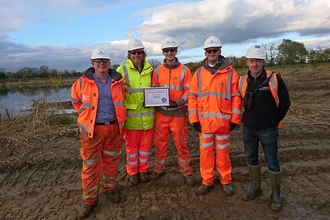The collaboration between The Wildlife Trusts and Intact Insurance, is rooted in a shared ambition: to advance the scientific and social understanding of nature-based solutions to flooding, while also delivering tangible, local impact. Together, we are working to understand and reduce climate-related risks, a defining trend for insurers, and championing nature-based solutions that strengthen the resilience of ecosystems, communities, and businesses.

At the national level, together we have commissioned new research to deepen insight into the benefits and mechanisms of Natural Flood Management (NFM). On the ground, the relationship comes to life through the Waterscapes Project run by Gloucestershire Wildlife Trust and Intact Insurance, which directly address rising flood risks across the county.
Flooding is a national concern, with 5.2 million properties in England - one in six - at risk.1 Two-thirds of the country’s infrastructure, including energy, water treatment, and transport systems, is vulnerable to flooding.2 By 2050, flood risk is expected to at least double,3 and the UK faces a projected daily water shortfall of 4 billion litres,4 even without drought conditions. The economic cost of a severe drought in London alone is estimated at £330 million per day5, yet national policy responses remain underdeveloped.
Understanding the benefits of Natural Flood Management
Published in March 2025, research conducted by Stantec on behalf of The Wildlife Trusts and Intact Insurance aimed to assess the full range of benefits delivered by NFM schemes already implemented or underway by local Wildlife Trusts, while also collating existing literature on the societal net benefits of NFM.
Emphasis was placed on the implications of these findings for decision-makers, including insurance providers, to support more informed, resilient, and nature-positive approaches to flood risk management.
The research drew its findings from 10 Wildlife Trust schemes across the country focused on different NFM techniques including beaver management, wetland creation, river restoration and urban solutions. Wildlife Trust staff collaborated with local communities and stakeholders to work to reduce flood risk on properties and the local area.
Although based on a small sample, average total benefits of Wildlife Trust Natural Flood Management schemes were estimated at £4 for every £1 over 10 years rising to £10: £1 over 30 years. This demonstrates the value in investing in such schemes now.
The research also revealed strong public concern about climate change, with 96% of respondents expressing worry and 78% already noticing its local impacts. A deep connection to nature was also evident, with 80% reporting that it contributed significantly to their happiness and wellbeing - correlating with pro-environmental behaviours.
The study also uncovered that public awareness of Natural Flood Management (NFM) is growing. While 58% had some knowledge and 24% claimed good understanding, over 70% supported nature-based approaches like tree planting and wetland restoration, far outweighing support for traditional hard engineering methods.
Read the full report

©Gillian Day
Rivers 2040
Rivers 2040 is an 18-month project from The Wildlife Trusts, Trent Rivers Trust and Intact Insurance that will map and analyse the economic, environmental and societal benefits of restoring nature along England's longest river from source to sea - the River Trent.
The Waterscapes Project
Gloucestershire Wildlife Trust and Intact Insurance have partnered to create Waterscapes, a programme that brings nature-based solutions to flooding to communities in Gloucestershire. As a Founding Partner, Intact Insurance funded Phase 1, to demonstrate how working with nature can reduce flood risk while boosting biodiversity in Cheltenham and Gloucester.
These nature-based solutions range from upstream interventions, such as leaky dams, to sustainable urban drainage systems (SuDS) within towns and cities. For example:
- At Gloucestershire Royal Hospital a circular rain garden can capture up to 800 litres of rainwater, while permeable paving encourages water to soak naturally into the ground.
- In Charlton Kings, residents worked with the Wildlife Trust to redesign their driveways with sustainable materials and methods. Nature corridors connect habitats for wildlife, while swales, wetlands, and leaky dams slow and redirect water.
- At Robinswood Hill Country Park, leaky dams made from felled ash trees help manage stormwater and support woodland biodiversity.
Highlights from Phase 1 of the Waterscapes programme include:
- 2.9 million litres of water storage created
- 120m² of impermeable surfaces removed
- 290 plants added for pollinators
- 10+ nature-based solutions implemented
- 30 community events engaging over 3,500 people, including 1,000 school children
The success of Phase 1 has launched Phase 2, expanding into Stroud and Tewkesbury, with ongoing support from Intact Insurance, the Environment Agency, and other partners. The Waterscapes project demonstrates how working with nature and communities can create resilient, thriving landscapes, while helping to reduce the risk of flooding.
Discover more about Waterscapes
Sources
- Environment Agency. (2009). Flooding in England: A National Assessment of Flood Risk (GEHO0609BQDS-E-E). Environment Agency. https://assets.publishing.service.gov.uk/media/5a7ba398ed915d4147621ad6/geho0609bqds-e-e.pdf GOV.UK Assets
- Public First. (2025, March). From risk to resilience: Report (PF_180325). Public First. https://www.publicfirst.co.uk/wp-content/uploads/2025/03/From-risk-to-resilience-report_PF_180325.pdf Public First
- Department for Environment, Food and Rural Affairs / GOV.UK. (n.d.). Environment Agency chair calls for new approach to flood and coastal resilience. https://www.gov.uk/government/news/environment-agency-chair-calls-for-new-approach-to-flood-and-coastal-resilience GOV.UK
- Department for Environment, Food and Rural Affairs / GOV.UK. (n.d.). England faces 5 billion litre public water shortage by 2055 without urgent action. https://www.gov.uk/government/news/england-faces-5-billion-litre-public-water-shortage-by-2055-without-urgent-action GOV.UK
- Greater London Authority. (n.d.). London’s water crisis. In London.gov.uk. https://www.london.gov.uk/who-we-are/what-london-assembly-does/questions-mayor/find-an-answer/londons-water-crisis




